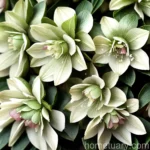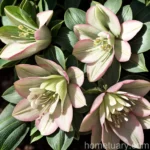Hellebore (Helleborus x hybridus ‘Pink Lady’): A Complete Guide
Hellebores, or Lenten Roses, are a beloved genus of perennial flowering plants that belong to the Ranunculaceae family. Among the various hellebore cultivars available, Helleborus x hybridus ‘Pink Lady’ is a standout variety, valued for its exquisite pink flowers and its ability to thrive in shaded garden areas. In this comprehensive guide, we will delve into the various aspects of the ‘Pink Lady’ Hellebore, including its culture, uses, care requirements, and more. Whether you are an experienced gardener or a newcomer to hellebores, this article will provide valuable insights into cultivating and enjoying this beautiful plant in your garden.
Key Takeaways – Helleborus x hybridus ‘Pink Lady’
Before we embark on this botanical journey, let’s highlight some key takeaways about the ‘Pink Lady’ Hellebore:
- Plant Name: Helleborus x hybridus ‘Pink Lady’
- Other Names: Pink Lady Lenten Rose, Pink Lady Hellebore
- Family: Ranunculaceae
- Type: Perennial Flowering Plant
- Flower Color: Pink
- Attributes: Evergreen, Shade-loving, Low-maintenance
- Use: Ideal for winter gardens and shaded areas
- Characteristics: Hardy, with disease-resistant properties
Now, let’s explore the various facets of this charming plant in more detail.
What is Hellebore (Helleborus x hybridus ‘Pink Lady’)?
Helleborus x hybridus, commonly known as the Hellebore or Lenten Rose, is a group of hellebore hybrids that are prized for their early-flowering, long-lasting blooms and evergreen foliage. One of the popular varieties within this group is the ‘Pink Lady’ Hellebore, which captivates gardeners with its delicate pink flowers. This enduring and low-maintenance plant is known for its ability to bloom during the winter and early spring, adding vibrancy to garden landscapes when few other plants are in flower.
Hellebores have a rich history and folklore associated with them. They have been cultivated for centuries and are often mentioned in ancient texts and herbal medicine practices. However, the ‘Pink Lady’ Hellebore, with its unique pink blossoms, brings a contemporary touch to traditional hellebore cultivars.
As we navigate through the subsequent sections, we will gain a deeper understanding of the culture, uses, care, and maintenance of the ‘Pink Lady’ Hellebore, empowering enthusiasts to cultivate and appreciate this exquisite plant in their own gardens.
Culture of Helleborus x hybridus ‘Pink Lady’
Understanding the cultural requirements of the ‘Pink Lady’ Hellebore is essential for successfully growing and enjoying this stunning plant. From suitable growing conditions to ideal planting locations, let’s explore the cultural aspects of this hellebore variety.
Uses
The ‘Pink Lady’ Hellebore can serve various purposes in garden landscapes, including:
- Winter Interest: The plant provides an early burst of color and interest in the garden during the winter months when many other plants are dormant.
- Shade Gardens: Ideal for shaded or woodland gardens, where its tolerance for low light conditions enhances the visual appeal of these areas.
- Cut Flower Arrangements: The attractive blooms can be cut and used in floral arrangements, bringing the beauty of the outdoors into indoor settings.
Water
Proper moisture is crucial for the health and vitality of the ‘Pink Lady’ Hellebore. Here are some insights into its water requirements:
- Well-drained Soil: It thrives in well-drained soil and does not tolerate waterlogged conditions, especially during the growing season.
- Regular Watering: While it is drought-tolerant once established, consistent watering is essential, particularly during dry spells and warm periods.
Sunlight
Hellebores, including the ‘Pink Lady’ variety, are known for their preference for shaded conditions. Understanding their sunlight needs is imperative for their overall well-being:
- Partial Shade to Full Shade: They flourish in partial shade to full shade, making them an excellent choice for gardens with limited direct sunlight.
- Protection from Harsh Sun: They benefit from protection against intense midday sun, especially in warmer climates.
Fertilizer
Proper nutrition is essential for the ‘Pink Lady’ Hellebore to thrive and produce abundant blooms. Here’s a glimpse into its fertilizer requirements:
- Balanced Fertilizer: Apply a balanced, slow-release fertilizer in early spring to support healthy growth and flowering.
- Minimal Fertilization: Hellebores are generally low-fertilizer plants and excessive fertilization should be avoided to prevent potential issues.
Soil
Understanding the soil preferences of the ‘Pink Lady’ Hellebore is pivotal for creating an optimal growing environment:
- Rich, Loamy Soil: It prefers fertile, well-draining, and slightly acidic to neutral soil.
- Amendment with Organic Matter: Amending the soil with organic matter such as compost enhances its structure and fertility, benefiting the plant.
Pruning
Pruning is an essential aspect of hellebore care, promoting plant health and vigor. Here’s a glimpse into the pruning requirements of the ‘Pink Lady’ Hellebore:
- Pruning Old Foliage: Remove any remaining old, tattered foliage in late winter or early spring to allow the new growth to emerge unobstructed.
- Deadheading: Gently remove spent flowers to maintain a tidy appearance and encourage continuous blooming.
Propagation
For those interested in propagating the ‘Pink Lady’ Hellebore, understanding the propagation methods is crucial:
- Division: Dividing mature clumps in early spring is a common and effective method of propagation.
- Sowing Seeds: Collecting and sowing fresh seeds in a suitable growing medium can also be a rewarding propagation method.
Container Popularity
While hellebores are primarily grown in garden landscapes, they are also favored for container cultivation. The ‘Pink Lady’ Hellebore’s attributes make it an excellent container plant, offering versatility and charm to outdoor living spaces.
The cultural insights provided above form the foundation for successful hellebore cultivation, ensuring that the ‘Pink Lady’ variety thrives and graces gardens with its elegant blooms.
Common Diseases and Disease Diagnosis
One of the factors contributing to the popularity of hellebores, including the ‘Pink Lady’ variety, is their resilience to diseases. However, as with any plant, there are potential issues to be aware of. Let’s explore some common diseases and their diagnosis in hellebores.
Disease Resistance
Hellebores, including the ‘Pink Lady’ variety, exhibit notable resistance to various diseases, adding to their allure as low-maintenance garden plants. Some of the common diseases they are resistant to include:
- Powdery Mildew: Hellebores are generally resistant to powdery mildew, a common fungal disease that affects many garden plants.
- Downy Mildew: Their robust nature often renders them resistant to downy mildew, a potentially damaging disease in humid conditions.
- Rust: Their strong disease resistance extends to rust, a fungal disease that can affect plant foliage.
Common Pests
While hellebores are resilient to many diseases, they can still encounter pest issues. Being familiar with common pests and their signs is beneficial for timely intervention and management. Some potential pests include:
- Aphids: These small, soft-bodied insects tend to congregate on young shoots and flower buds, causing distortion and stunted growth.
- Leaf Miners: The larvae of certain insects, known as leaf miners, create serpentine mines in the leaves, potentially compromising the plant’s vigor.
- Snails and Slugs: These mollusks can cause significant damage to hellebores, especially in damp and shaded garden environments.
Botanist’s Tips
To maintain the vitality and beauty of the ‘Pink Lady’ Hellebore, here are some expert tips from botanists and horticulturists:
- Regular Inspection: Routinely inspect the plant for signs of pests or diseases, enabling early detection and prompt intervention.
- Cultural Practices: Implement proper cultural practices, including adequate spacing, good air circulation, and minimal stress to the plant, to bolster its natural resilience.
- Integrated Pest Management: Employ environmentally sensitive integrated pest management strategies to manage potential pest issues effectively.
Understanding the potential diseases and pests that may affect hellebores equips gardeners to proactively safeguard their plants and foster a thriving garden environment.
Fun Facts about Helleborus x hybridus ‘Pink Lady’
As we immerse ourselves in the world of hellebores, particularly the captivating ‘Pink Lady’ variety, let’s discover some intriguing and lesser-known facts about these enchanting plants:
- Landscape Charm: The ‘Pink Lady’ Hellebore contributes to the charm and allure of winter gardens, providing a delightful burst of color when the garden may appear bleak.
- Longevity: Hellebores are long-lived plants, with some specimens living for decades, making them valuable additions to garden landscapes.
- Botanical Intrigue: The flower structures of hellebores are not just visually stunning but also hold botanical fascination, with intricate petal-like sepals and prominent stamens.
- Folklore and Traditions: Hellebores have been associated with various folklore and traditions, symbolizing themes such as protection, healing, and hope.
- Breeding Advancements: Ongoing hellebore breeding efforts have resulted in an array of captivating colors and forms, expanding the diversity of hellebore offerings for garden enthusiasts.
These fun facts offer glimpses into the rich tapestry of hellebores, shedding light on their multifaceted appeal and enduring allure in garden settings.
Botanical Classification of Helleborus x hybridus ‘Pink Lady’
To gain a deeper understanding of the ‘Pink Lady’ Hellebore, it is insightful to explore its botanical classification, providing insights into its lineage and taxonomic associations.
Taxonomy and Nomenclature
- Kingdom: Plantae
- Clade: Angiosperms
- Order: Ranunculales
- Family: Ranunculaceae
- Genus: Helleborus
- Species: Helleborus x hybridus
Understanding the botanical classification of hellebores, including the ‘Pink Lady’ variety, underscores their taxonomic relationships and their place within the plant kingdom.
Links to External Resources
To further enrich your knowledge and appreciation of the ‘Pink Lady’ Hellebore, here are linkages to valuable external resources that offer additional insights and guidance:
- Royal Horticultural Society – Hellebores
- The American Hellebore Society
- Missouri Botanical Garden – Helleborus x hybridus
- The Hardy Plant Society
- University of Maryland Extension – Hellebore production and use
- Hellebore Gardens and Nurseries
These external resources present a wealth of information, ranging from cultivation tips and plant profiles to dedicated organizations and societies focused on hellebores and their cultivation.
In conclusion, the ‘Pink Lady’ Hellebore, with its alluring pink flowers and low-maintenance nature, enriches garden landscapes and brings a touch of elegance to shaded areas. By familiarizing ourselves with its cultural requirements, potential uses, and resilience to diseases and pests, we can cultivate and enjoy this captivating plant with confidence. Whether showcased in a woodland garden, a container display, or as cut flowers in floral arrangements, the ‘Pink Lady’ Hellebore is a delightful addition to any garden, offering enduring beauty and charm.
The allure of hellebores extends beyond their aesthetic appeal, encompassing botanical intrigue, rich folklore, and long-lasting contributions to garden landscapes. With ongoing breeding advancements and an array of captivating varieties, hellebores, including the ‘Pink Lady’ cultivar, continue to captivate garden enthusiasts and botanical admirers year after year.
So, whether you are captivated by the elegance of the ‘Pink Lady’ Hellebore or are inspired to explore the diverse world of hellebores, this guide serves as a valuable resource, empowering you to delve deeper into the enchanting realm of these exquisite plants.
Helleborus x hybridus, Pink Lady Hellebore, or the ‘Pink Lady’ Lenten Rose, with its captivating pink flowering perennial, invites us into a world of winter garden enchantment, infusing our landscapes with enduring beauty and charm. Discover the allure of hellebores and unleash their timeless elegance in your garden today!















